Spirea or meadowsweet is a type of deciduous ornamental shrubs of the Pink family. Translated from Greek, "speira" means "bend", and the validity of this name is confirmed by the special flexibility of the spirea branches. The main advantage of spirea is its simplicity. Spirea has more than 100 varieties of shrubs growing in semi-deserts, forest-steppe and steppe.
Content
Japanese spirea: photos and types
Shrubs of the genus Spirea can be either dwarf (20 cm) or rather tall (up to 2.5 m). The roots are fibrous and shallow. The branches are recumbent or outstretched, erect or creeping, from bright burgundy to dark, the bark can flake longitudinally. Leaves are alternate, petiolate, have 3-5 lobes, rounded or lanceolate. The flowers of the shrub are small, but numerous, and can form a wide variety of inflorescences - spike-shaped, paniculate, corymbose, pyramidal.
The color of the buds is varied, from pure white to pink. In different varieties of spirea, inflorescences are located in different ways.: in some it is completely along the shoot, in some it is only on top of the shoot or only at the end of the branches. Spireas propagate by seeds, dividing the bush, cuttings or layering.
Wangutta bush is used for group plantings, for hedges. Dwarf species are great for organizing living carpets, rocky gardens and rose gardens. Spirea looks beautiful as an independent plant.
Varieties and varieties of spirea
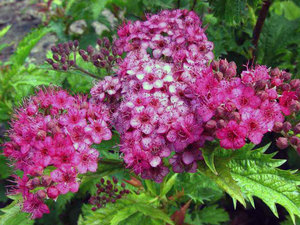 Some varieties and varieties of spirea are often used in culture, some are quite rare. By flowering time, all shrubs are divided into:
Some varieties and varieties of spirea are often used in culture, some are quite rare. By flowering time, all shrubs are divided into:
- Summer blooming;
- Spring blooming.
Spring flowering spireas
They are characterized by early flowering, and also differ in that they have flowers of various shades of a pure white shade, blooming on last year's shoots. It begins to bloom only in the second year of the life of the shoot. These plants are characterized by dense tillering. The following types of spirea are popular in gardening.
Gray spirea
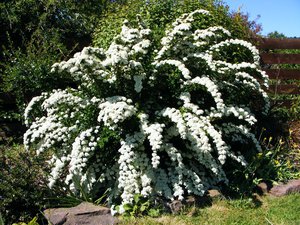 This is a hybrid of whitish-gray and St. John's-leaf spirea - in reality it is white spirea, and it is called gray because of the color of the leaves. The plant reaches a size of about 190 cm, drooping branches, lanceolate leaves from below are gray, corymbose buds of white color are located along the entire length of the shoot. It starts flowering from early May to early July. The most common types.
This is a hybrid of whitish-gray and St. John's-leaf spirea - in reality it is white spirea, and it is called gray because of the color of the leaves. The plant reaches a size of about 190 cm, drooping branches, lanceolate leaves from below are gray, corymbose buds of white color are located along the entire length of the shoot. It starts flowering from early May to early July. The most common types.
"Grefsheim"
The height and diameter of this variety is 1.6–2.1 m, red-brown branches, spreading crown, drooping branches, flowers up to 1.1 cm in size, double, pure white, gathered in umbrellas. The bush is a melliferous plant, flowering duration up to 50 days, begins to bloom from 2 years old.
Spirea Wangutta
Wangutta is a hybrid of a three-lobed and Cantonese spirea - a large shrub with a height and diameter of up to 2.5 m, drooping branches, three-lobed leaves, bare, toothed, gray-gray below, rich green above, in autumn they acquire an orange-red color. Wangutta's multiple globular buds are composed of pure white flowers in a circle up to 0.7 cm and are located along the entire perimeter of the branch.It begins to bloom in early July, in rare cases it blooms again in September.
Spirea nippon
Under natural conditions, it grows on about. Honshu, grows up to 2.1 m, the crown is thick and spherical, has horizontal branches, leaves up to 5 cm, blooms for up to one month from the end of May with corymbose flowers of green-yellow colors up to 1.5 cm in size, while it has purple flowers in bud.
Spirea Argut
The earliest of spring blooming flowers. Sprawling shrub 1.6–2.1 m in size, has a rather attractive appearance, and flowering branches that are composed of multiple white fragrant flowerslocated on all branches. This variety of spirea blooms for one month from the beginning of June.
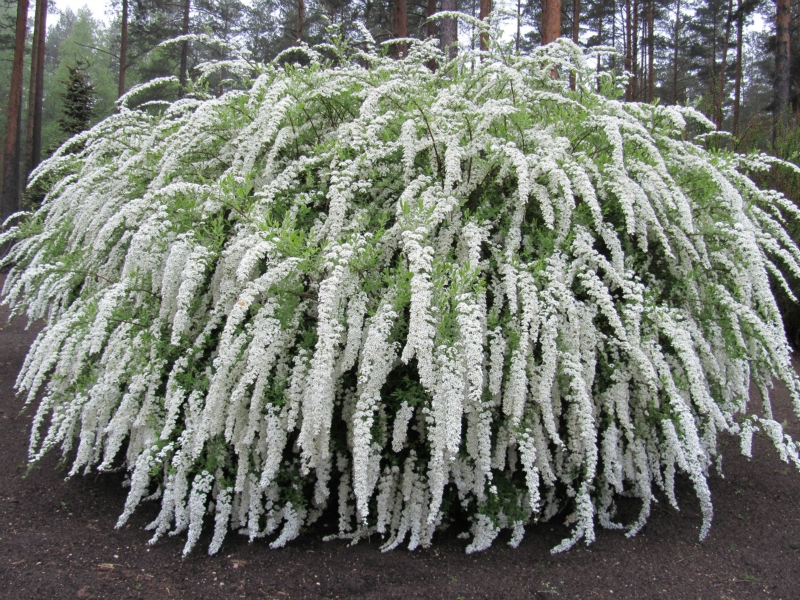

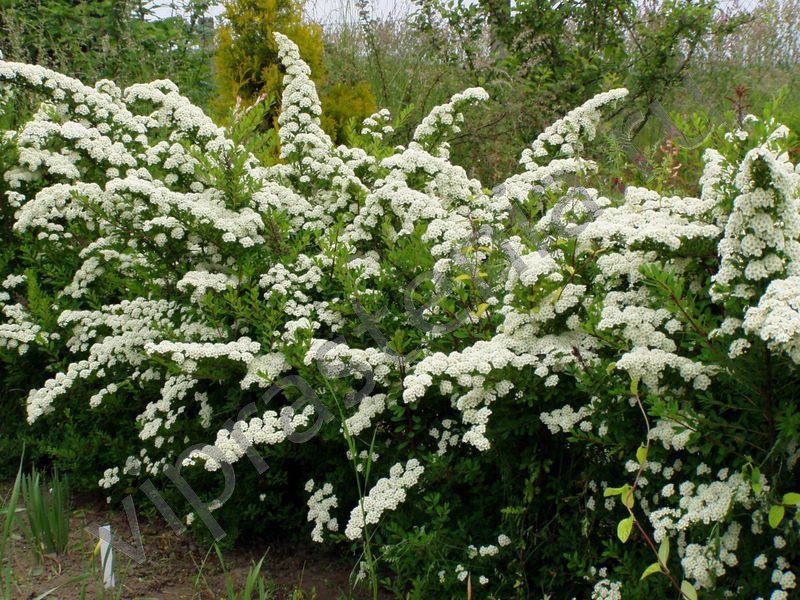
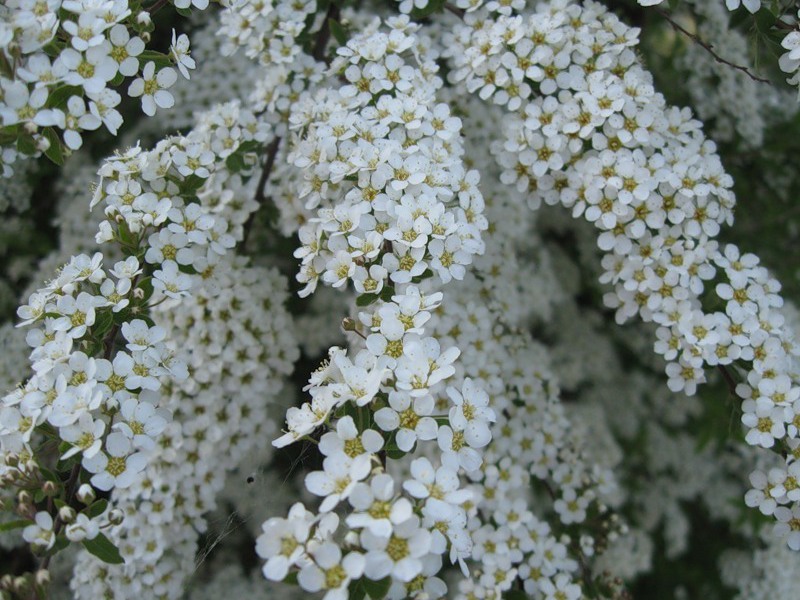
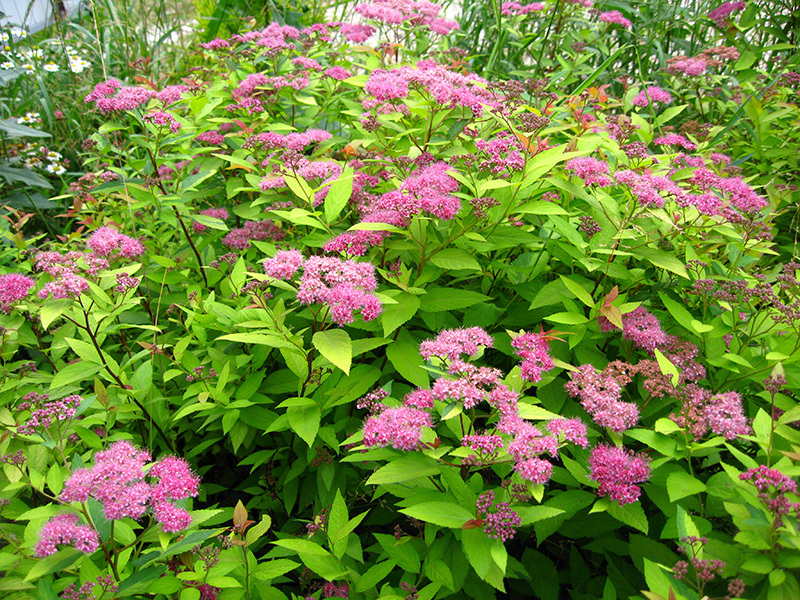
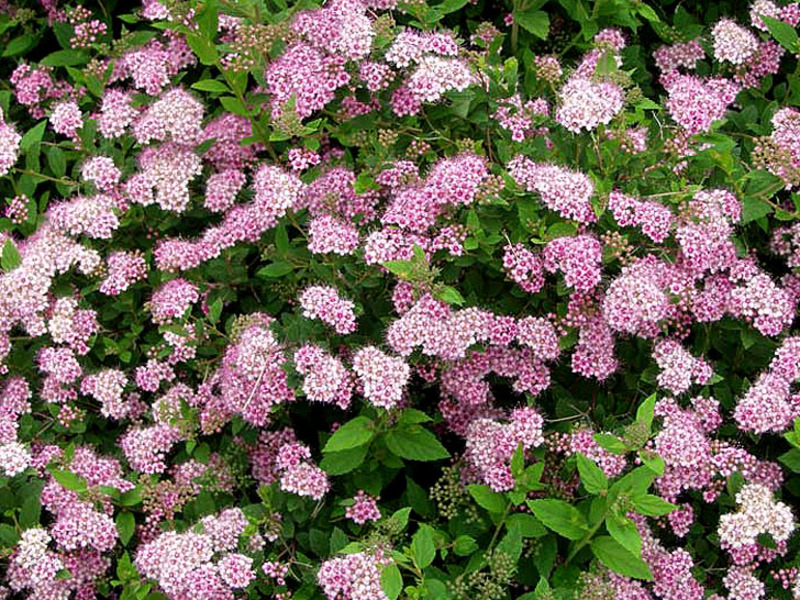
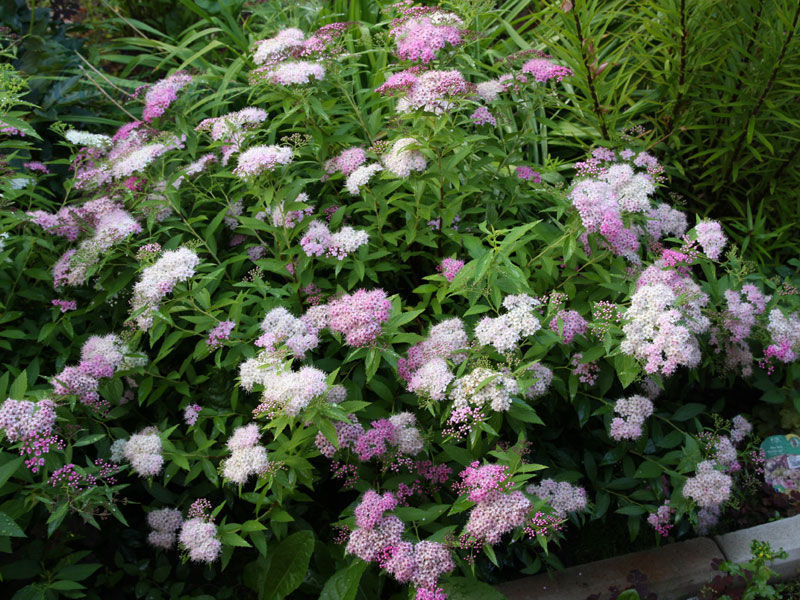
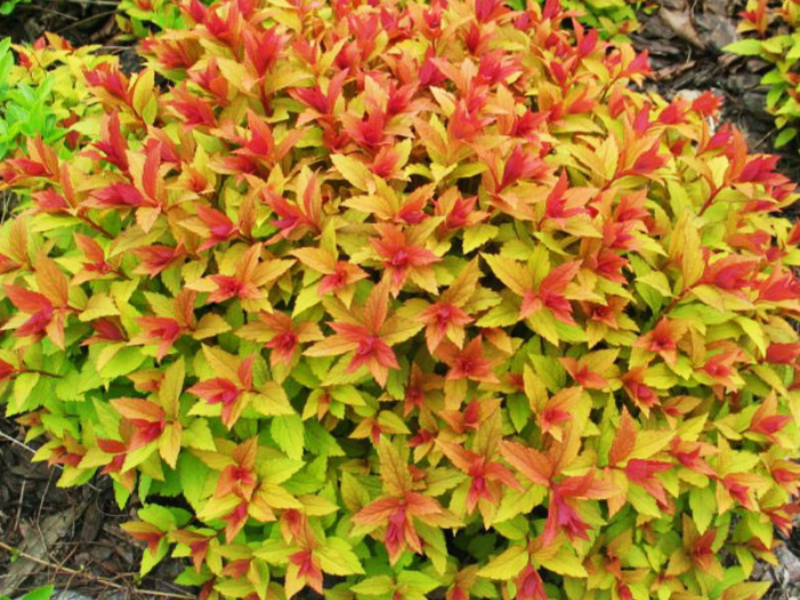
Summer blooming spireas
These are varieties where the inflorescences are at the end of young shoots and in which last year's shoots dry out over time, in the first place, represented by varieties of Japanese spirea... In most of its varieties, Japanese spirea is pink in color, but in rare cases it can be red-pink.
Japanese spirea
A beautiful plant with tomentose branches when young and bare when old. Up to 1.1–1.6 m in size, the leaves are ovoid and oblong, gray-gray below, green above, purple, red, yellow in autumn. Japanese spirea blooms for up to 50 days with pink-red buds collected in corymbose inflorescences located at the ends of the shoots. The most common varieties.
Little princesses
The plant is only 0.7 m in size, the crown is 1.3 m in circumference, rounded, the leaves are rich green, oval, corymbose buds consist of pink-red flowers 4-5 cm in diameter, begins flowering at the end of June.
Golden princesses
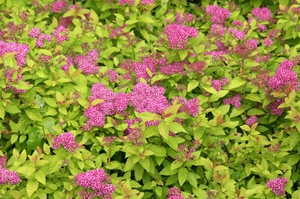 One of the types of the above-described variety differs in that it can grow up to 1.1 m and has yellow leaves.
One of the types of the above-described variety differs in that it can grow up to 1.1 m and has yellow leaves.
Shirobana
A low-growing bush (0.7-0.9 m), but the crown size is 1.3 m, the leaves are small (3 cm), rich green, narrow-lanceolate. The buds are pink or white, beginning to bloom in early July.
Goldflame
The bush is 0.9 m high, the orange-yellow leaves become deep yellow after a while, then green, and in the fall - bright orange. The buds are pink-red, small in size.
Crisp
A low openwork bush up to 0.5 m in size and slightly wider, multiple erect shoots, a spherical crown, flowers - flat umbrellas 5.6 cm in size consist of small bright pink inflorescences with a lilac tint, begins flowering in June.
In addition to the Japanese spirea, there are the following varieties of summer flowering plants.
Boomald
This is a hybrid of white-flowered and Japanese spirea - a low bush 60–90 cm in size. The branches are erect. Leaves are green in summer, yellow, purple, red in autumn. Flowering lasts about 2 months. The most cultivated variety of spirea Bumald Goldflame... This plant is 0.7 cm in size, the leaves are silvery-orange at first, then turn bright gold, then deep green, and in autumn they are bright red. But such changes take place when the plant is in the sun.
Willow spirea
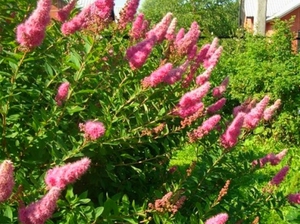 The bush is 2 m high with upright branches of a brown-red-yellow hue, the leaves have a pointed shape, up to 15 cm in size, pink or white buds are collected in pyramidal inflorescences approximately 25 cm in size.
The bush is 2 m high with upright branches of a brown-red-yellow hue, the leaves have a pointed shape, up to 15 cm in size, pink or white buds are collected in pyramidal inflorescences approximately 25 cm in size.
Spirea Douglas
Shrub 1.5 m in size with pubescent and straight brown-red branches. Leaves 4–9 cm in size, deep pink, oblong buds are collected in pyramidal, apical inflorescences, flowering lasts 1.5 months, starting in June.
Billard
This is a hybrid of willow and Douglas spirea - plant size up to 2.1 m, lanceolate leaves up to 12 cm long, deep pink flowers, collected in narrow pyramidal inflorescences. Begins flowering in early July.
Growing features
Any plant has certain requirements for both growing and care. Spirea also has some features:
- Spirea prefers sod or leafy soil. The best composition: one part of peat and sand and 2 parts of land;
- A drainage layer is definitely required;
- The spirea is planted in a hole, which is 1/3 larger than the butt of the bush;
- Planting depth - not less than 1.5 m, while the root collar of the shrub must be at the surface level;
- It is necessary to plant spirea in cloudy weather, ideally in the rain. The best time is the end of August;
- Desired neighbors - thuja, spruce, juniper.
Planting in spring
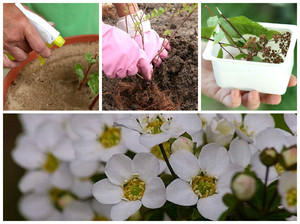 In spring, only summer spireas are planted. The main condition for planting in the spring is to have time before the leaves begin to bloom. When you purchase seedlings of a plant, carefully examine the root system - it should not be very dry. Look at the condition of the seedling's shoots, and purchase only if they have good buds and they are flexible. Adjust the planting raw materials:
In spring, only summer spireas are planted. The main condition for planting in the spring is to have time before the leaves begin to bloom. When you purchase seedlings of a plant, carefully examine the root system - it should not be very dry. Look at the condition of the seedling's shoots, and purchase only if they have good buds and they are flexible. Adjust the planting raw materials:
- When the roots are damaged or very dry, cut off the branches;
- When the roots of the seedling are very large, shorten them.
If the roots are dry during storage, then spill them with water, and only then plant.
Red spirea is an unpretentious flower to care for, but for abundant and long-term flowering, you still need to comply with certain conditions: the land must be fertile, and the site must be illuminated by the sun. In addition, spirea bushes create abundant root growth, which increases the area that the flower occupies, and this must be taken into account when planting spirea.
In the place where the bush will be planted, it is necessary to dig a hole with clearly sheer walls, at least 1/3 larger than the size of the roots of the seedling. Then you need to let the pit stand for 3-5 days... On the day of planting (it is best to have rainy weather), it is necessary to make a drainage layer of 16-22 cm from broken brick, add sod or leaf soil, as well as sand and peat to the pit, mix it all, put the roots of the plant in the pit, throw earth and then compact. Immediately after planting, the bush is watered with 1-2 buckets of water.
Planting in autumn
In autumn, both late-flowering and spring-flowering plants are planted. As a rule, autumn planting is combined with planting by dividing the bush. This must be done before the leaf fall is over. Plants that are about 4 years old are transplanted and divided, older bushes can also be planted, but this is already more difficult to do because of the large clod of earth, which is difficult to wash off.
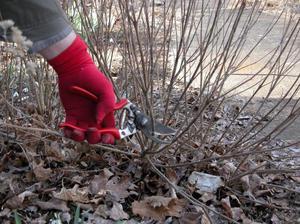 The bush must be dug out, capturing slightly more than half of the crown projection in diameter. Most likely, you will need to chop off a couple of roots, but this will not cause severe damage to the bush. After the roots of the extracted plant, it is necessary to thoroughly wash... If the bush is young and has not grown much, just place it in a bucket of water and let the earth soften and settle in the container, then wash the roots under running water, straightening them at the same time. Cut the plant into 2-3 pieces with pruning shears so that each has a root lobe and some strong shoots.
The bush must be dug out, capturing slightly more than half of the crown projection in diameter. Most likely, you will need to chop off a couple of roots, but this will not cause severe damage to the bush. After the roots of the extracted plant, it is necessary to thoroughly wash... If the bush is young and has not grown much, just place it in a bucket of water and let the earth soften and settle in the container, then wash the roots under running water, straightening them at the same time. Cut the plant into 2-3 pieces with pruning shears so that each has a root lobe and some strong shoots.
Make a hole, put a mound in the center, place a seedling on it and level the roots. Cover the hole with earth. Water the bush several times.
Plant care
We have already mentioned the basic requirements:
- good drainage;
- fertile and loose soil;
- bright lighting;
- mulching with peat immediately after planting.
What else is needed for the plant to please you with long and beautiful flowering?
Since the spirea has shallow roots, it does not tolerate dry soil well and dries up, therefore it requires moderate watering in the dry season: 16 liters each. water per plant twice a month... Loosening of the soil is mandatory, as is periodic weeding. The plant is fed with mineral additives after cutting the bush, and in July it is advisable to fertilize the bush with a mullein solution.
Of the pests, spireas are usually annoyed by spider mites and aphids. The tick can be destroyed by karbofos, and aphids can be killed by pyrimor.But most often spireas are not susceptible to disease, and pests do not cause severe harm.
Pruning
Spiraea grows strongly, therefore, it is periodically necessary to trim. In early flowering, since flowering occurs along the entire length of the shoot, only the tips that are frozen over the winter are trimmed every year, but after 10 years, all old shoots are removed from the plantThus, the bush is cut almost to the stump, so that then from the most 4-7 healthy young shoots to form a new bush, cutting off other shoots during the growing season. After a few years, old or weak shoots are removed from the plant again. At the ends of the shoots, pruning must be done in the spring, before the leaves bloom.
Summer flowering plants are pruned every year in May. It is necessary to cut the shoot up to large buds; it is advisable to remove small and weak shoots altogether. The stronger the pruning, the more powerful the shoots will be. Periodically, you need to remove the aging shoots, otherwise they will dry out on their own. When the plant is 4 years old, you can cut the spirea every year to a height of 35 cm from the surface of the earth, but if then the bushes have weak growth, you need to think about replacing the flower, although, in general, late-flowering varieties live for 16-21 years.
By the photo of the spirea in landscape design, one can judge the high decorativeness and versatility of this flower in different seasons of the year. In spring, the bushes are early covered with beautiful variegated or green leaves, after which there is an abundant and long flowering, even after which the spirea does not lose its attractiveness.


